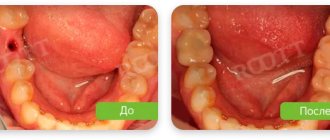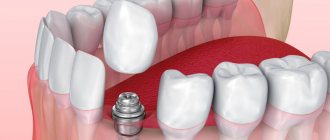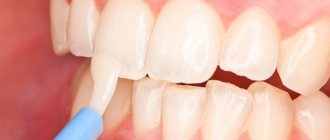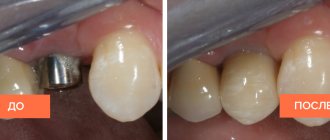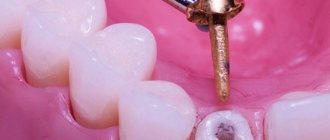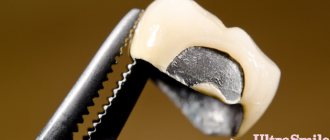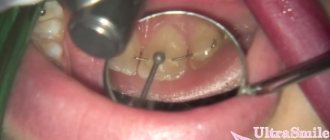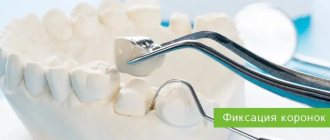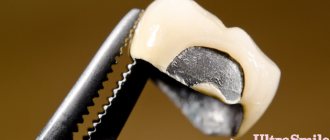Installing a temporary crown on an implant
Not all implantation methods involve installing a temporary crown on the implant. This is only possible when using a one-stage technique with instant loading. As a rule, the method is used to restore front teeth. The possibility of installing a temporary crown on an implant is also associated with the special structure of artificial roots used for one-stage implantation. Firstly, these implants are one-piece, that is, they are already connected to an abutment, onto which the prosthesis is then attached. And secondly, such structures are equipped with a special thread, so they seem to be screwed into the bone tissue without the need to drill out a place in it for the implant, as is done with the two-stage technique. In this regard, implants for a one-stage implantation procedure are attached more securely, and therefore are able to withstand the weight of a temporary crown and normal chewing load from the first days of installation.
Care of the provisional product
Since the plastic (plastic) crown is fixed on a temporary cement mortar, the fastening strength is low. If you chew toffee or gum, the likelihood of the product coming off the tooth is quite high. Therefore, during the period of operation, doctors recommend reducing the chewing activity of the area where the temporary structure is installed. Even when brushing your teeth, you need to be careful with the plastic so as not to damage it.
If the temporary crown comes off, you need to place it in a glass of water overnight, and the next day go to an appointment with a treating specialist.
Reception is conducted by specialists
Do I need a temporary crown for an implant?
Do I need to put temporary crowns on implants? If the operation is performed in the smile area, then it is advisable to do this. Natural pressure when chewing food will activate metabolic processes in bone tissue and stimulate their restoration. Moreover, the installed crown will help achieve a beautiful gum contour and also prevent the loss of soft tissue. As for the implantation of chewing teeth, according to most experts, it is better to carry out the operation in two stages with delayed installation of the crown.
How to attach
The provisional crown is fixed on the ground tooth using a temporary cement composition. But it often happens that the foundation has already been destroyed, and only the root remains. Then they do an x-ray. If the root is healthy, the canal is opened and the nerve is removed. A hole is drilled in the root and either a pin is installed there, followed by restoration of the missing part of the tooth, or a stump inlay is made. The latter option is more reliable and durable. Then a temporary crown is put on the stump tab.
Making temporary crowns for implants
Temporary crowns for dental implants are in most cases made of plastic. Please note that metal-ceramics, all-ceramics and zirconium are used to make permanent crowns for implants. If a doctor offers to make a temporary crown, for example, from metal ceramics, think about his honesty and competence. It may happen that the same structure will be installed twice: as a temporary and permanent one. Of course, for a double fee.
The role of “temporary solutions” in the case of dental implantation
If one or more teeth have been missing for a long time, and also if the tooth was deliberately “removed from the bite” in order to reduce the load until it is restored, the task of the temporary restoration is “to load the teeth and help them remember their function.” In this way, the correct distribution of the chewing load is restored and the functioning of the entire dental system is improved.
Temporary restorations, made from softer materials than permanent ones, prevent injury to the teeth until the doctor selects their ideal closure.
During this period, the shape of the teeth being restored is corrected and it is easier and cheaper to do this with a temporary restoration. A correctly selected tooth shape prevents accelerated abrasion and chipping, both on the restored tooth and on opposing teeth.
Inaccuracies in the anatomical shape can not only cause discomfort to the patient and lead to chips of the enamel, but in the future cause diseases of the temporomandibular joint if it does not adapt to the new bite.
Another important task of temporary restoration, especially when it comes to restoring a missing tooth with an implant, is creating the correct gingival contour around the future permanent crown.
Temporary crowns allow you to create a beautiful and natural gum contour in place of a lost tooth.
Why else are temporary crowns needed if the tooth is restored with an implant?
For example, in order not to leave empty space in the dentition, because this can lead to the displacement of adjacent teeth and antagonist teeth.
Now you know almost everything “why” an orthopedic doctor may recommend the temporary prosthetics stage.
Of course, temporary restorations are not used in all cases, but this will be known during the consultation after examination and diagnosis.
How long does it take to make a temporary crown on an implant?
Direct method.
The doctor takes an impression using silicone mass, pours a plastic solution into it and puts it all on the implant. Once the resin has cured, the silicone impression is removed and the temporary crown remains on the implant. It is given the required shape, polished and ground, and then secured with special cement.
- Quickly produced.
- Similar to natural teeth.
- Porosity, due to which there is a risk of infection.
- Discoloration due to coloring products.
- Short service life.
- More fragile.
Indirect method.
Based on the casts, a plaster model of both jaws is created in the laboratory, which is used to make a wax crown. A temporary plastic crown is created using the wax model. Sometimes, in the manufacture of plastic crowns, a metal base is used to extend the service life of the products.
- More durable compared to crowns made using the direct method.
- The individual characteristics of the patient are taken into account.
- No.
Making temporary crowns for implants using the direct method in an orthopedist’s office will take no more than an hour. A dental laboratory will make a temporary crown made of plastic in a couple of days.
Metal-plastic crowns –
In addition to crowns made entirely of plastic, there are also so-called “metal-plastic crowns” (synonym – metal-plastic crowns). Such crowns have a metal frame, which is lined with a plastic overlay on the front side. Such crowns have more or less acceptable aesthetics, and also have a fairly long service life - up to 5 years.
Structurally, metal-plastic crowns for teeth are made like cast crowns (made of cobalt-chromium alloy) - with an additional plastic facet on the front surface. The advantage of such crowns is their more or less acceptable aesthetics, as well as maintainability. For example, if a plastic veneer chips, it can be repaired directly in the mouth, i.e. a metal-plastic crown does not require removal from the tooth for such repairs.
The disadvantages include their cost, which is already very close to the cost of economy-class metal ceramics made from budget materials (about 5,000 rubles in 2021). An absolute disadvantage is that plastic facets can quickly lose their aesthetic properties and negatively affect the condition of the gums around the crown. We hope that our article: Plastic crowns reviews was useful to you!
Sources:
1. Personal experience as a dentist, 2. “Orthopedic dentistry. Textbook" (Trezubov V.N.), 3. National Library of Medicine (USA), 4. https://www.realself.com/, 5. "Crowns and bridges in orthopedic dentistry" (Smith B.).
What to do if a temporary crown on an implant falls out or is swaying?
Sometimes temporary crowns on implants begin to wobble due to poor-quality fixation or poor implant abutment. However, there are cases when the patient cannot determine exactly what has become unstable - the temporary crown or the artificial root itself. Therefore, at the first signs of mobility of the temporary prosthesis on the implant, you should immediately contact the doctor who performed the implantation procedure. Only he will be able to correctly determine the condition of the artificial root and more securely attach a temporary crown to it.
Wearing period
There is no point in wearing temporary crowns for a long time; they are usually used until the time comes to install permanent structures. On average, this is no more than two weeks, but in complex cases it may take a little longer. In any case, the attending physician will definitely orient his patient regarding the timing of treatment.
Of course, if desired, the patient can wear temporary dentures for several months. But over time, chips may appear on them, and they may change the original shade. A temporary crown helps to quickly get used to a permanent prosthesis; as a result, a person does not feel discomfort and practically does not feel the presence of a foreign object in the mouth.
The cost of such crowns will largely depend on the material used by the master, as well as on the manufacturing method. The direct method allows for significant savings; ready-made dentures also cost less. In this case, you will have to choose: high quality and aesthetic component or low cost.
Why are temporary crowns placed before permanent ones?
It may seem that a temporary crown is an extra material cost and should not be included in the cost of prosthetics.
Let us dwell once again on the need to use temporary crowns and emphasize their main advantages.
- Psychological calm.
Imitating your own teeth allows you to maintain self-confidence without introducing an imbalance in your daily activities (during business negotiations, smiling, talking, etc.). - Safety of soft tissues of the oral cavity
(prevention of inflammation and atrophy). - Preserving the functionality of teeth.
Thanks to the complete chewing process, possible undesirable consequences for the digestive system are eliminated. - No problems with diction.
- Fast adaptation.
Getting used to the future permanent prosthesis is much easier if you wear temporary crowns first. - Economy.
A temporary crown is a quick “reanimation” of teeth at an affordable cost.
How long can you walk with a temporary crown?
Temporary crowns are a quick restoration of the aesthetics and functionality of teeth until permanent dentures are installed. Their service life is the time required to create permanent orthopedic structures, as well as implant healing. When can a permanent prosthesis be installed on an implant? Up to 4 months is the healing period of the implant in the lower jaw, up to 6 months in the upper jaw. After this, permanent dental prosthetics can be performed.
In some cases, for example, after implantation of All-on-4, All-on-6, a temporary prosthesis can last up to two years. During this time, the patient will have time to financially prepare for the installation of a high-quality permanent prosthesis. If the patient uses a temporary crown for a long time, it is necessary to come to the clinic every six months for a preventive examination. When worn for a long time, the following complications may occur:
✔
abrasion of crowns, leading to displacement of adjacent teeth;
✔
inflammation of the gums due to the accumulation of bacteria on plastic;
✔
gum growth and pain due to damage to the crown.
To make a temporary crown on an implant last longer:
- avoid sticky and hard foods;
- brush your teeth gently, without pressing hard on the area where the implant is installed;
- floss as carefully as possible.
Treatment of a tooth for a crown
The doctor’s task at this stage, like a sculptor’s, is to “cut off all unnecessary” from the tooth, giving it a strictly defined shape. Two things are most important: an even and clear ledge formed near the gum itself, as well as the shape of the tooth and especially the inclination of its walls in relation to each other. These two parameters mainly affect the final quality of the crown and its service life.
The ledge on the tooth is needed so that the edge of the future crown fits evenly onto it. If the doctor does not form a ledge, the edge of the crown will hang between the tooth and the gum, which will inevitably lead to the accumulation of plaque around it, which means inflammation of the gums and tooth caries around this very edge of the crown, and the appearance of an unpleasant odor from the crown. It is important that the ledge is as smooth and even as possible. After all, it is the precise, uniform fit of the edge of the crown to it that is the main factor in the long service life of the restoration.
This photo shows approximately what the tooth should look like after the preparation is completed (in this case it is the upper canine). The arrows indicate the ledge on which the edge of the crown will subsequently sit. It is also clearly visible here that the opposite walls of the tooth are almost parallel to each other, and converge at a slight degree (ideally 6-8 degrees).
The shape of the stump after finishing the treatment should roughly resemble the anatomy of a full-fledged tooth (not a Christmas tree, not the roof of a house in a child’s drawing, not a stump or a carnation, but the shape of an intact tooth). This is necessary so that the dental technician can then model a beautiful and functional, i.e. a design that is easy to chew, and not just a flat “table” that can only be used to crush food and not chew. The opposite walls of the tooth should be almost parallel, only slightly converging towards each other. This shape is a guarantee that the crown will serve for a long time and will not disintegrate under the influence of constant chewing loads. If the tooth is “filled with a house”, the tooth stump will be too short - this will inevitably lead first to depressurization of the crown (i.e. it will still stay on the tooth, but microflora from the oral cavity will already begin to get under it), and then to its complete loss.
And here you can clearly see what a tooth should not look like after preparation. The lack of a ledge and too much taper of the tooth stumps led to rapid decementation of the crowns, dental caries and inflammation of the marginal gums...
What other important points are there at this stage? It’s probably worth mentioning once again that when treating living teeth for crowns , the doctor must work with A LOT of cooling. Overheating of the tooth threatens the rapid development of nerve inflammation with all the ensuing consequences in the form of root canal treatment and possible reworking of the crown. Here we can make a small digression on the need for complete removal of nerves in all teeth that go under crowns. The most important thing to remember is that the crown itself is not an indication for tooth depulpation. But this approach, unfortunately, is present in many orthopedists, especially those stuck in the Soviet school of dentistry. Working with living teeth needs to be much more careful and precise, and in general it is more difficult. In addition, there is a chance that a living tooth may become ill under the crown and the structure will have to be removed and probably redone. To protect themselves, first of all, some doctors depulpate any tooth that goes under a crown, indiscriminately. In fact, this is quite definite harm and excess of indications. The main indications are: a strong tilt of the tooth, its protrusion from the dental arch, as well as the presence of deep caries.


